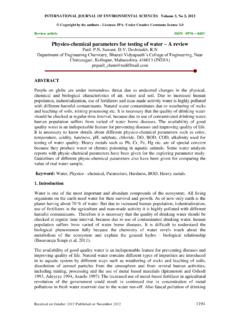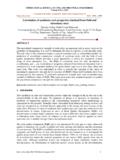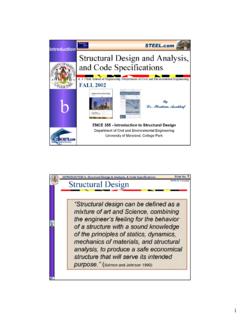Transcription of Solution of Shear Wall Location in Multi-Storey Building
1 INTERNATIONAL JOURNAL OF CIVIL AND structural engineering Volume 2, No 2, 2011 Copyright 2010 All rights reserved Integrated Publishing services Research article ISSN 0976 4399 Received on September, 2011 Published on November 2011 493 Solution of Shear Wall Location in Multi-Storey Building Anshuman. S1, Dipendu Bhunia2, Bhavin Ramjiyani3 1- Assistant Professor, Civil engineering Group, BITS Pilani, Rajasthan, India 2- Assistant Professor, Civil engineering Group, BITS Pilani, Rajasthan, India. 3- Higher Degree student, Civil engineering Group, BITS Pilani, Rajasthan, India ABSTRACT Shear wall systems are one of the most commonly used lateral-load resisting systems in high-rise buildings.
2 Shear walls have very high in-plane stiffness and strength, which can be used to simultaneously resist large horizontal loads and support gravity loads, making them quite advantageous in many structural engineering applications. There are lots of literatures available to design and analyse the Shear wall. However, the decision about the Location of Shear wall in Multi-Storey Building is not much discussed in any literatures. In this paper, therefore, main focus is to determine the Solution for Shear wall Location in Multi-Storey Building based on its both elastic and elasto-plastic behaviours. An earthquake load is calculated and applied to a Building of fifteen stories located in zone IV. Elastic and elasto-plastic analyses were performed using both STAAD Pro 2004 and SAP V (2000) software packages.
3 Shear forces, bending moment and story drift were computed in both the cases and Location of Shear wall was established based upon the above computations. Keywords: linear behaviour of Shear wall, Non-linear behaviour of Shear wall, seismic analysis, STAAD Pro 2004 and SAP V (2000) Introduction Reinforced concrete framed buildings are adequate for resisting both the vertical and the horizontal load acting on them. However, when the buildings are tall, beam and column sizes workout quite heavy, so that there is lot of congestion at these joint and it is difficult to place and vibrate concrete at these places, which fact, does not contribute to the safety of buildings. These practical difficulties call for introduction of Shear wall. The term Shear wall is rather misleading as such a walls behave like flexural members.
4 They are usually used in tall buildings and have been found to be of immense use to avoid total collapse of buildings under seismic forces. It is always advisable to incorporate them in buildings built in region likely to experienced earthquake of large intensity or high winds. The design of these Shear wall for wind are design as simple concrete walls. The design of these walls for seismic forces requires special considerations as they should be safe under repeated loads. Shear walls may become imperative from the point of view of economy and control of lateral deflection. There are lots of literatures available [Cardan, B. (1961), Syngellakis et al. (1991), Wight et al. (1991), Qiusheng et al. (1994), White et al. (1995) and Rosowsky, (2002)] to design and analyse the Shear wall.
5 However, any of these literatures did not discuss much about the Location of Shear wall in Multi-Storey Building . Hence, this paper has been described to determine the proper Location of Shear wall based on its elastic and elasto-plastic behaviours. A RCC medium rise Building of 15 stories subjected to earthquake loading in Zone IV has been considered. In this regard, both STAAD Pro 2004 Solution of Shear Wall Location in Multi-Storey Building Anshuman. S, Dipendu Bhunia, Bhavin Ramjiyani International Journal of Civil and structural engineering Volume 2 Issue 2 2011 494 and SAP V (2000) software packages have been considered as two tools to perform. Shear forces, bending moments and storey drifts have been calculated to find out the Location of Shear wall in the Building . The plan of the Building without Shear wall as shown in Figure 1 has been considered to carry out the study.
6 Both STAAD PRO 2004 and SAP V (2000) software packages have been considered. The preliminary data as per the Table 1 is taken up for this study. Figure 1: Plan of the Building without Shear Wall Table 1: Preliminary Data Zone IV External wall 250mm thick including Plaster Ground storey height From Foundation Internal wall 150mm thick including Plaster Floor to floor height Grade of Concrete and steel M20 and Fe 415 Size of exterior column 300 500 mm2 Number of storeys FIFTEEN (G+14) Size of interior column 300 300 mm2 Shear wall thickness 300 mm Size of beams in longitudinal and transverse direction 300 450 mm2 Depth of slab 150 mm Ductility design IS:13920-1993 Loading consideration Dead Load (DL) and Live load (LL) have been taken as per IS 875 (Part 1) (1987) and IS 875 (Part 2) (1987), respectively. Seismic load calculation has been done based on the IS 1893 (Part 1) (2002) s approach.
7 Results and Discussions It has been seen from Table 2 that the top deflection (when the seismic load direction is in the shorter dimension) has been exceeded the permissible deflection, times the total height of the Building [IS 1893 (Part 1) (2002)] in STAAD PRO 2004. It has been exceeded for the load combinations (DL+EQ) and + , respectively. Solution of Shear Wall Location in Multi-Storey Building Anshuman. S, Dipendu Bhunia, Bhavin Ramjiyani International Journal of Civil and structural engineering Volume 2 Issue 2 2011 495 Table 2: Maximum Deflection at the Roof without Shear Wall Software Load Combination Calculated Deflection (mm) Permissible Deflection (mm) [IS 1893 (Part 1) (2002)] STAAD PRO 2004 (DL+LL+EQ) (DL+EQ) + SAP V (2000) (DL+LL+EQ) (DL+EQ) + Similarly, bending moment and Shear force were maximum at the ground level in 1st and 12th frames, respectively (Table 3).
8 Table 3: Maximum Bending Moment and Maximum Shear Force at the Ground Level without Shear Wall Frame No. Software Load Combination Calculated Bending Moment (kN-m) Calculated Shear Force (kN) 1st and 12th STAAD PRO 2004 (DL+LL+EQ) (DL+EQ) + SAP V (2000) (DL+LL+EQ) (DL+EQ) + Hence, for the above reason Shear wall was provided in 1st and 12th frames, respectively (Figure 2). Figure 2: Plan of the Building with Shear Wall in 1st and 12th frames It has been observed from Table 4 that the roof deflection was well within the permissible limit for all cases after providing the Shear wall in 1st and 12th frames, respectively. Solution of Shear Wall Location in Multi-Storey Building Anshuman. S, Dipendu Bhunia, Bhavin Ramjiyani International Journal of Civil and structural engineering Volume 2 Issue 2 2011 496 Table 4: Maximum Roof Deflection after Providing Shear Wall in the 1st and 12th Frame Software Load Combination Calculated Deflection (mm) Permissible Deflection (mm) [IS 1893 (Part 1) (2002)] Without Shear Wall With Shear Wall STAAD PRO 2004 (DL+LL+EQ) (DL+EQ) + SAP V (2000) (DL+LL+EQ) (DL+EQ) + It has also seen from Table 5 that both bending moment and Shear force were increased at the ground level in 1st and 12th frames after providing Shear wall in 1st and 12th frames.
9 Table 5: Maximum Bending moment and Shear Force at the Ground Level after providing Shear Wall in the 1st and 12th Frame Software Load Combination Calculated Bending Moment (kN-m) Calculated Shear Force (kN) STAAD PRO 2004 (DL+LL+EQ) (DL+EQ) + SAP V (2000) (DL+LL+EQ) (DL+EQ) + Further, Shear walls have been provided in the interior frames, 6th and 7th frames as per the following figure 3. Figure 3: Plan of the Building with Shear Wall in 6th and 7th frames It has been seen from the Table 6 that roof deflection was well within the permissible deflection for all cases after providing the Shear wall in 6th and 7th frames, respectively. Solution of Shear Wall Location in Multi-Storey Building Anshuman. S, Dipendu Bhunia, Bhavin Ramjiyani International Journal of Civil and structural engineering Volume 2 Issue 2 2011 497 Table 6: Maximum Roof Deflection after Providing Shear Wall in the 6th and 7th Frame Software Load Combination Calculated Deflection (mm) Permissible Deflection (mm) [IS 1893 (Part 1) (2002)] Without Shear Wall With Shear Wall STAAD PRO 2004 (DL+LL+EQ) (DL+EQ) + SAP V (2000) (DL+LL+EQ) (DL+EQ) + It has also seen from Table 7 that both bending moment and Shear force were increased at the ground level in 6th and 7th frames after providing Shear wall in 6th and 7th frames.
10 Table 7: Maximum Bending Moment and Maximum Shear Force at the Ground Level after providing Shear Wall in the 6th and 7th Frame Software Load Combination Calculated Bending Moment (kN-m) Calculated Shear Force (kN) STAAD PRO 2004 (DL+LL+EQ) (DL+EQ) + SAP V (2000) (DL+LL+EQ) (DL+EQ) + Elasto-plastic analysis Mahin and Bertero (1976) employed the wide-column frame analogy to assess the importance of the strength and stiffness of the coupling beams on the elastic and nonlinear, static, and dynamic responses of multi-story, coupled Shear -wall models to severe earthquake excitation. In wide column frame analogy Shear wall has been modeled as a wide column having same dimension of Shear wall and Shear wall is connected to frame by connecting beam. Here Shear walled frame has been modeled in SAP 2000 vs.



















